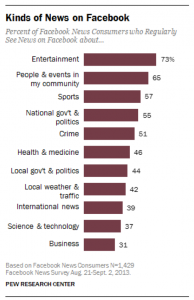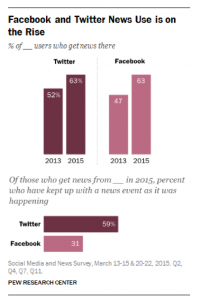 Guest blog by Damian van Woerden
Guest blog by Damian van Woerden
Social Media is becoming the new delivery service for news. People no longer want to wait for news, pay for news, or be told what news is important for them. Jeff Sonderman, a professor of digital journalism at Georgetown University, states that journalism on social media today is nearly equal to television news (Sonderman, 2012). He goes on to say that one third of adults under the age of 30 get their news from social media.
The big question now is: How do I get accurate and reliable news?
The answer varies depending on what you, as a news reader, are looking for in the news. Not all social media sites share the same types of news articles. In addition, with different forms of social media come different levels of reliability in news reporting.

News on Facebook
Anderson and Caumont (2014) tell us that Facebook tends to have more articles surrounding entertainment and sports. Their research shows that many articles shared on Facebook are lengthy and cover topics that are designed to gain interest and ‘likes’. This style of marketing news information is done by making news bits appear in our news feed as full size articles (Anderson & Caumont, 2014). News articles are usually quite large and require the reader to scroll down a page. As a result, not very many Facebook users follow breaking news or developing news events. Facebook has developed instant articles to increase viewer ship and, as a result, increase revenue from advertising. The two big benefits of Facebook, however, are being able to comment on news pieces and reading the articles that are shared by people on your friends list. After all, information shared by our friends most likely will interest us as well.

News via Twitter
People who read the news on Twitter view different content than those who follow news on Facebook (Barthel, Shearer, Gottfried, & Mitchell, 2015). Since twitter only allows 140 characters per post, news information is brief, to the point, and gets updated frequently. As a result, news followers on Twitter are more likely to follow breaking news and developing news events. This ability to get quick updates quickly allow followers to get highlights on complicated news stories, such as politics and/or international news (Barthel, Shearer, Gottfried, & Mitchell, 2015). Twitter developed a new app for cellphones called Twitter Moments. This app displays all the biggest and most important news information easily for anyone to use. While news may not be marketed to gain specific followers, journalists use Twitter as a way to connect fast with an audience and keep them up to date with important news.
Gleaning accurate news
As a news reader, I want to make sure I am reading the most reliable and most accurate information on an event. The most common suggestions to find accurate news are the following:
• Follow a journalist on social media
• “Like” and Follow a reputable news organization
• Read multiple news articles on the same event
• Do not repost information that may be faulty
By following these suggestions, you can be sure to glean the best and most accurate news from social media.
With social media taking over the production and distribution of news, the quality of information being presented will begin to decrease. For the regular news reader, the real questions relating to gleaning accurate news are now:
What role will social media play in news reporting in the next 5 years?
Will newspapers, or even TV, still be relevant?
Will they disappear or just adapt like radio did after the TV was developed?
How will this effect the quality of my news information?
References
Anderson, M., & Caumont, A. (2014, 24 September). How social media is reshaping news. Retrieved from http://www.pewresearch.org/fact-tank/2014/09/24/how-social-media-is-reshaping-news/
Barthel, M., Shearer, E., Gottfried, J., & Mitchell, A. (2015, July 14). The Evolving Role of News on Twitter and Facebook. Retrieved from http://www.journalism.org/2015/07/14/the-evolving-role-of-news-on-twitter-and-facebook/
Facebook brings “instant articles” to News Feed. (2013, May 12). The Verge YouTube Channel. Retrieved from https://www.youtube.com/watch?v=zPvGF5bO0xs
News [image]. Retrieved from https://encrypted-tbn1.gstatic.com/images?q=tbn:ANd9GcSkimkX8gAzzLaHINhT_z9AnF-TKHkQt04Gi8cLq_iJTep9btuc
Sonderman, J. (2012, September 27). One-third of adults under 30 get news on social networks now. Retrieved from http://www.poynter.org/2012/one-third-of-adults-under-30-get-news-on-social-networks-now/189776/
Twitter Moments wants to make following the news easy. (2015, October 2015). The Verge YouTube Channel. Retrieved from https://www.youtube.com/watch?v=ah3vW6tzUiE
*******************************
About the author:
Damian van Woerden @CanadianDamian is a student at the University of the Fraser Valley studying Media and Communications as well as Criminology and Criminal Justice. He enjoys studying the effects of television and the role of news media in society. His goal is to graduate by January 2017 with a Bachelors of Arts degree and to find a full-time job in law enforcement.

